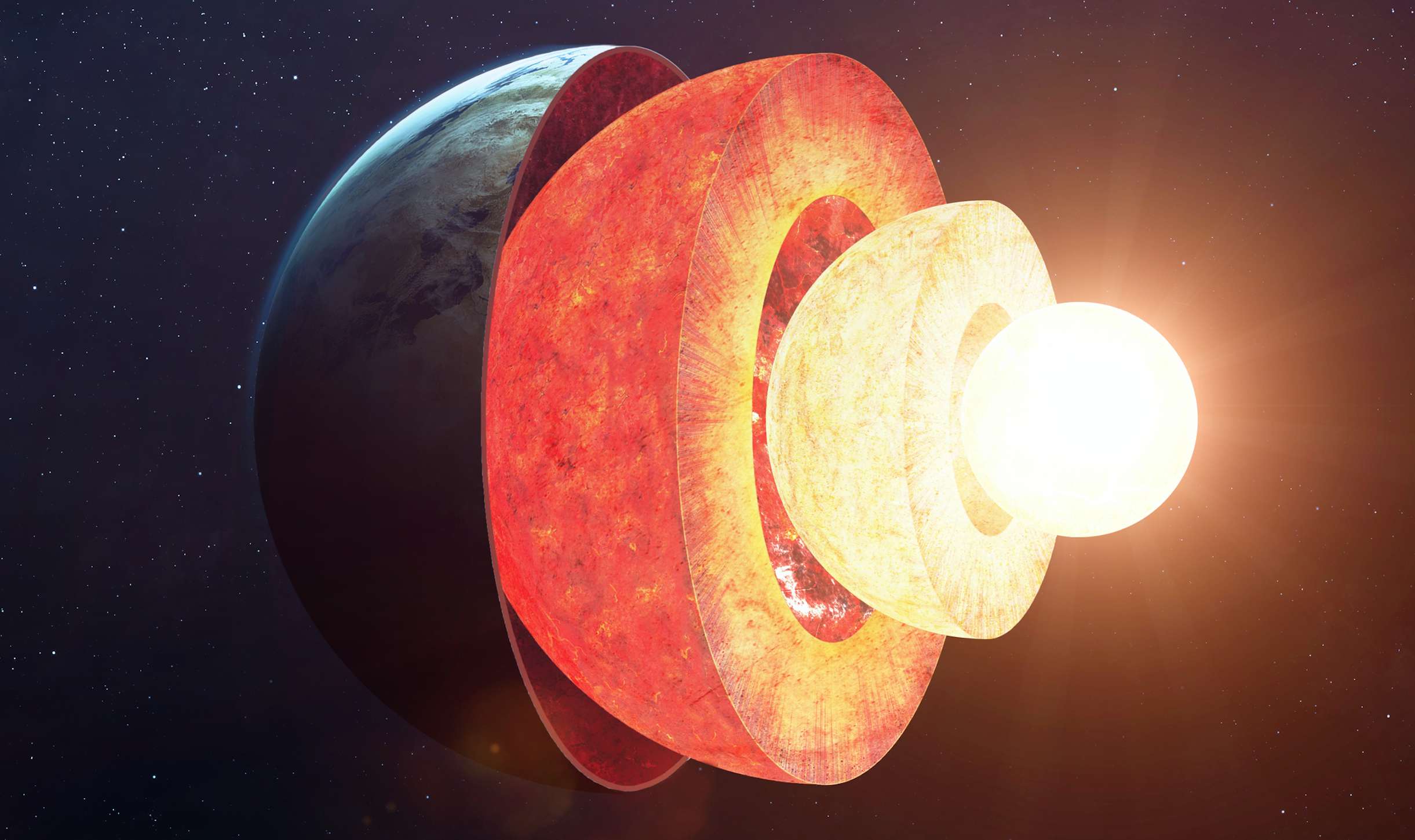
The outer core is a fascinating and crucial component of the Earth's structure, playing a pivotal role in the planet's dynamic processes. This molten layer, located beneath the Earth's mantle, is primarily composed of iron and nickel. Its high temperature and fluid nature contribute to the generation of Earth's magnetic field, which shields the planet from harmful solar radiation.
Understanding the outer core is essential for comprehending the Earth's geophysical phenomena, such as seismic waves and geomagnetic activities. In this article, we will delve into 31 captivating facts about the outer core, shedding light on its composition, properties, and significance in the broader context of Earth science. From its role in shaping the Earth's magnetic field to its influence on geological processes, the outer core holds a wealth of intriguing secrets waiting to be unveiled. Join us on this exploration as we uncover the mysteries of the outer core and gain a deeper appreciation for the dynamic forces that shape our planet.
Key Takeaways:
- The outer core, made of molten iron and nickel, generates Earth’s magnetic field and protects us from solar winds, shaping our planet’s geophysical landscape.
- Despite being inaccessible, the outer core’s fluid dynamics and intense heat play a crucial role in Earth’s geological history and ongoing scientific exploration.
The outer core is composed of molten iron and nickel.
Beneath the Earth's rocky mantle lies the outer core, a fluid layer primarily consisting of molten iron and nickel. This molten state is attributed to the intense heat generated by the planet's core.
It is situated beneath the Earth's mantle.
The outer core occupies the region beneath the Earth's solid mantle, extending from a depth of approximately 2,890 kilometers to 5,150 kilometers.
The outer core is in a liquid state.
Unlike the solid inner core, the outer core exists in a liquid state due to the high temperatures that prevent the iron and nickel from solidifying.
The outer core is responsible for generating Earth's magnetic field.
The dynamic movements within the outer core, driven by the process of convection, produce Earth's magnetic field through a geophysical phenomenon known as the dynamo effect.
It plays a crucial role in protecting the Earth from solar winds.
The magnetic field generated by the outer core serves as a protective shield, deflecting solar winds and preventing them from stripping away the Earth's atmosphere.
The outer core's temperature ranges from 4,300 to 5,000 degrees Celsius.
The outer core experiences incredibly high temperatures, with estimates ranging from 4,300 to 5,000 degrees Celsius, surpassing the melting points of iron and nickel.
It is approximately 2,260 kilometers thick.
The outer core's thickness measures around 2,260 kilometers, accounting for a substantial portion of the Earth's radius.
The outer core's density is lower than the Earth's solid inner core.
While the outer core is denser than the Earth's mantle, its density is lower than that of the solid inner core due to its molten composition.
Seismic waves travel at different speeds through the outer core.
Seismic waves, generated by natural phenomena such as earthquakes, travel at varying speeds as they pass through the outer core, providing valuable insights into its composition and characteristics.
The outer core's behavior influences Earth's geological processes.
The motions and interactions within the outer core significantly impact Earth's geological activities, contributing to phenomena such as plate tectonics and volcanic eruptions.
It is inaccessible to direct exploration.
Due to its location beneath the Earth's surface, the outer core remains beyond the reach of direct exploration, presenting a challenge for researchers seeking to study its properties firsthand.
The outer core's composition influences the Earth's overall magnetic behavior.
The molten iron and nickel within the outer core play a pivotal role in shaping the Earth's magnetic behavior, influencing compass needles and facilitating navigation.
The outer core's movements are driven by heat differentials.
The transfer of heat within the outer core fuels its convective movements, driving the circulation of molten materials and contributing to the generation of Earth's magnetic field.
It is integral to the Earth's geodynamo system.
The outer core's dynamic processes are fundamental to the Earth's geodynamo system, which sustains the planet's magnetic field and its vital protective functions.
The outer core's existence was inferred through geophysical studies.
By analyzing seismic waves and their behaviors, scientists inferred the existence and properties of the outer core, unraveling its significance in Earth's geology.
The outer core's properties influence the behavior of seismic waves.
The characteristics of the outer core, such as its molten composition and density, influence the propagation and behavior of seismic waves, aiding scientists in mapping the Earth's interior.
It plays a role in shaping the Earth's internal structure.
The outer core's fluid nature and composition contribute to shaping the Earth's internal structure, influencing its magnetic, geological, and geophysical properties.
The outer core's dynamics impact the Earth's rotational behavior.
The movements and convection currents within the outer core influence the Earth's rotational dynamics, contributing to the planet's overall behavior and orientation in space.
It is a crucial subject of study in geophysics and seismology.
The outer core serves as a focal point for research in geophysics and seismology, offering valuable insights into the Earth's interior and its dynamic processes.
The outer core's properties are inferred through indirect observations.
Given the inaccessibility of the outer core, scientists rely on indirect observations and computational models to infer its properties and behavior, contributing to our understanding of the Earth's interior.
It is a key component of Earth's layered structure.
The outer core, situated between the solid inner core and the rocky mantle, forms a crucial component of the Earth's layered structure, influencing its overall geophysical behavior.
The outer core's properties impact the Earth's magnetic pole movements.
The characteristics and movements within the outer core contribute to the shifting of the Earth's magnetic poles, influencing navigation and magnetic orientation.
It is a realm of intense pressure and heat.
The outer core experiences extreme pressures and temperatures, creating an environment of intense heat and immense geological forces.
The outer core's properties are crucial for understanding planetary formation.
Studying the outer core's properties provides valuable insights into planetary formation processes, shedding light on the Earth's evolution and its place within the solar system.
It is a realm of complex fluid dynamics.
The fluid nature of the outer core gives rise to intricate fluid dynamics, shaping the planet's magnetic field and influencing its geological phenomena.
The outer core's behavior is linked to Earth's geological history.
The movements and interactions within the outer core are intertwined with Earth's geological history, leaving imprints on the planet's past and present geophysical landscape.
It is essential for understanding Earth's magnetic reversals.
The outer core's properties and behaviors are integral to comprehending Earth's magnetic reversals, offering insights into the planet's magnetic history and long-term geological processes.
The outer core's properties are crucial for planetary comparisons.
By studying the outer core's properties, scientists can draw comparisons with other planetary bodies, enhancing our understanding of planetary geophysics and magnetic behaviors.
It is a realm of ongoing scientific exploration and discovery.
The outer core continues to captivate scientific curiosity, driving ongoing exploration and research to unravel its complexities and deepen our understanding of Earth's inner workings.
The outer core's properties are integral to Earth's overall geophysical stability.
Understanding the outer core's properties and behaviors is essential for comprehending Earth's geophysical stability, magnetic field dynamics, and long-term planetary evolution.
The outer core's mysteries continue to inspire scientific inquiry and fascination.
The enigmatic nature of the outer core fuels scientific inquiry and fascination, prompting researchers to delve deeper into its mysteries and unlock the secrets of Earth's dynamic inner realm.
The outer core stands as a captivating enigma, holding profound implications for our understanding of Earth's geology, magnetic behavior, and planetary evolution. Through ongoing scientific endeavors, the mysteries of the outer core gradually unfold, enriching our comprehension of the planet's intricate dynamics and its enduring geological legacy.
Conclusion
In conclusion, the outer core is a fascinating and integral part of the Earth's structure. Its molten iron and nickel composition, coupled with its immense heat and pressure, generate the planet's magnetic field, which shields us from harmful solar radiation and enables compasses to point north. Understanding the outer core's properties and behavior is crucial for comprehending Earth's dynamics and geophysical processes. As we continue to delve into the mysteries of the outer core through scientific research and technological advancements, we gain valuable insights into the forces that shape our planet and the natural phenomena that impact our lives.
FAQs
What is the significance of the outer core?
The outer core plays a crucial role in generating Earth's magnetic field, which shields the planet from harmful solar radiation and facilitates navigation using compasses.
How is the outer core studied?
Scientists study the outer core through various methods, including seismic wave analysis, magnetic field measurements, and laboratory experiments simulating high-pressure and high-temperature conditions.
Was this page helpful?
Our commitment to delivering trustworthy and engaging content is at the heart of what we do. Each fact on our site is contributed by real users like you, bringing a wealth of diverse insights and information. To ensure the highest standards of accuracy and reliability, our dedicated editors meticulously review each submission. This process guarantees that the facts we share are not only fascinating but also credible. Trust in our commitment to quality and authenticity as you explore and learn with us.


